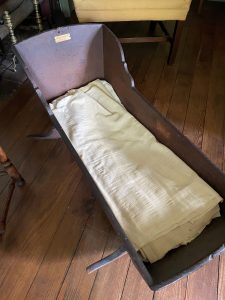By Emily Clark
Before the bridge bearing his name carried cars and trucks over the Housatonic River, Moses Wheeler carried passengers across the same stretch of water as the operator of the first ferry from Stratford to Milford—over 350 years ago. Providing a crucial transportation service, the Wheeler family continued to operate the ferry in southwestern Connecticut for three generations.
Life in Early Stratford
Born in Kent, England in 1598, Wheeler immigrated to America in the 1630s, arriving first in Boston before making his home in New Haven and eventually in Stratford. He married Miriam Hawley and became a farmer and one of the town’s largest landowners after purchasing tracts of land where Stratford and South Avenues are today. Wheeler’s deed was the first entry in Stratford’s land record book.
A ship carpenter by trade, Wheeler profited by living near the water and building vessels in addition to farming his extensive fields. As early as the 1640s, residents living along the Housatonic River—then called the Great River or the Stratford River—desired ferry service between the small communities of Stratford and Milford. In 1648, the General Court in Fairfield granted Wheeler, who had already built his own ferry, a contract to begin service.
Ferry Service Begins
The town of Stratford leased to Wheeler approximately 40 acres of land to construct a wharf, create a walkway, and keep all elements in good condition (the town agreed to pay for any needed improvements). From the streets of the village, Wheeler constructed a ferry road through the salt marsh near today’s Washington Bridge. His 21-year, renewable contract stated that no additional boats—private or otherwise—could transport passengers for any fee across the river. Travelers were “to be ferried over for one half penny per person and two pence for horse or beast.”
Called a “rough ferryman” and one of “almost giant stature,” Wheeler was a powerful man of endurance. In the History of Stratford 1639-1939, author William Howard Wilcoxson wrote that “Moses Wheeler was a picturesque character of indomitable courage, incredible height and remarkable strength”—qualities that were beneficial for crossing the river in all conditions. He had to ably carry passengers through a half-mile channel, often consisting of strong currents, floods, and stormy winds. His ferries—which he built himself to accommodate up to four people traveling by foot—were narrow-beamed, heavy-planked rowing boats. Later, the ferry added horseboats with large, wide beams that were able to hold a thousand pounds for passengers with animals.
Most of Wheeler’s passengers were local residents, tradesmen, and travelers lodging at taverns in Milford and Stratford. They benefitted from this ferry service across the river, which Wheeler provided for over half a century.
Three Generations of Service
When Wheeler’s second lease expired in 1690, the 92-year-old ferryman chose to retire. He wrote to the town committee of Stratford, saying, “For the natural love and affection yt I have to my beloved son Samuel Wheeler, I doe by these presents transmit all my right, title and interest of ye ferry in the bounds aforesaid with all benefits and profitable improvements accrewing thereunto by virtue of any gift, grant or lease whatsoever.” Samuel Wheeler’s own son Elnathan eventually inherited the ferry service—it remained in the Wheeler family for three generations and over one hundred years.
Just days after his one hundredth birthday, Moses Wheeler died at his home in Stratford. He was possibly New England’s first white centenarian of European descent. His gravestone, still standing in Stratford’s Old Congregational Burying Ground, reads: “Moses Wheler, Aged 100, Dyed Jan. 15th. 1698.” Connecticut built Interstate 95’s Moses Wheeler Bridge, one of the state’s longest and busiest bridges, in 1958 across the Housatonic and named the bridge in honor of the river’s first ferry captain.
Emily Clark is a freelance writer and an English and Journalism teacher at Amity Regional High School in Woodbridge.











